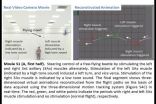New targets for rabies prevention and treatment
2015-03-16
(Press-News.org) Researchers have identified genes that may be involved in determining whether an individual is sensitive or resistant to rabies virus infection.
Through a screening method involving mouse embryonic stem cells, the investigators uncovered 63 genes, some with roles in the immune response, that represent potential targets for prevention or treatment. The wide variety of functions of the genes that were identified points to numerous interactions between the host and the virus at all stages of infection.
"Our study is the first to show that libraries of mutant stem cells can be differentiated into different cell types en mass and screened to identify meaningful genes involved in a cell's response to infection. Moreover, this technique can be used to identify host-based genes involved in any type bacterial or viral infection, or even response to drugs, toxins, or radiation," said Dr. Deeann Wallis, lead author of the Stem Cells study. "This is a relatively novel way for researchers to discover gene function and assess host response."
INFORMATION:
ELSE PRESS RELEASES FROM THIS DATE:
2015-03-16
Ecotourism has motivated efforts to reintroduce lions to landscapes where they were not previously common. A new analysis conducted after 4 lions were reintroduced into the fenced Tembe Elephant Park, South Africa, reveals that lions might compete with humans in winter, spring, and autumn and with endemic herbivores in all seasons but winter.
Despite the use of fencing to limit conflicts, communities that reintroduce carnivores continually balance the rewards associated with ecotourism and the risks to human safety and species conservation. The findings are published ...
2015-03-16
Contrary to common public perception, Canadian taxpayers could save billions by the introduction of a universal public drug plan to provide prescriptions to all Canadians, according to new research published in CMAJ (Canadian Medical Association Journal).
Canada is the only developed country with universal health insurance that does not also offer universal prescription drug coverage.
"A long-time barrier to the implementation of universal prescription drug coverage in Canada has been the perception that it would necessitate substantial tax increases," writes Dr. Steven ...
2015-03-16
Canada could save $7.3 billion annually with universal public coverage of medically necessary prescription drugs.
Canada is the only developed country with a universal health care system that does not include prescription drug coverage.
New research from the University of British Columbia and University of Toronto, published today in the Canadian Medical Association Journal , shows that universal public drug coverage, also known as universal pharmacare, is within reach for Canada even in times of government fiscal constraint.
"It's a win-win," said Steve Morgan, ...
2015-03-16
ANN ARBOR--Whether you're baking bread or building an organism, the key to success is consistently adding ingredients in the correct order and in the right amounts, according to a new genetic study by University of Michigan researchers.
Using the baker's yeast Saccharomyces cerevisiae, Patricia Wittkopp and her colleagues developed a novel way to disentangle the effects of random genetic mutations and natural selection on the evolution of gene expression. Their findings are scheduled for online publication in the journal Nature on March 16.
"These results tell us that ...
2015-03-16
A new study from the University of Birmingham and the MRC Cognition and Brain Sciences unit in Cambridge has shown how intentional recall is beyond a simple reawakening of a memory; and actually leads us to forget other competing experiences that interfere with retrieval. Quite simply, the very act of remembering may be one of the major reasons why we forget.
The research, published today in Nature Neuroscience, is the first to isolate the adaptive forgetting mechanism in the human brain. The brain imaging study shows that the mechanism itself is implemented by the suppression ...
2015-03-16
The largest genetic study of tuberculosis (TB) susceptibility to date has led to a potentially important new insight into how the pathogen manages to evade the immune system. Published today in the journal Nature Genetics, the study advances understanding of the biological mechanisms involved in TB, which may open up new avenues to design efficient vaccines for its prevention.
TB, caused by infection with the pathogen Mycobacterium tuberculosis, is a major global public health problem. According to the World Health Organization, in 2013 nine million people fell ill with ...
2015-03-16
A Venezuelan evolutionary biologist and a US zoologist state that they have refuted, through mitochondrial DNA sequencing, a recent claim, also based on such sequencing, that unknown type of bear must exist. in the Himalayas and that it may be, at least in part, the source of yeti legends. Their study was published in the open access journal ZooKeys.
Last year, B. Sykes and co-authors, in the course of mitochondrial DNA sequencing identification of hair samples that had been attributed to "anomalous primates" (yetis, bigfoots, and others), claimed to have found that ...
2015-03-16
Berkeley -- Hard-wiring beetles for radio-controlled flight turns out to be a fitting way to learn more about their biology. Cyborg insect research led by engineers at the University of California, Berkeley, and Singapore's Nanyang Technological University (NTU) is enabling new revelations about a muscle used by beetles for finely graded turns.
By strapping tiny computers and wireless radios onto the backs of giant flower beetles and recording neuromuscular data as the bugs flew untethered, scientists determined that a muscle known for controlling the folding of wings ...
2015-03-16
In the face of global climate change, increasing the use of renewable energy resources is one of the most urgent challenges facing the world. Further development of one resource, solar energy, is complicated by the need to find space for solar power-generating equipment without significantly altering the surrounding environment.
New work from Carnegie's Rebecca R. Hernandez (now at University of California Berkley), Madison K. Hoffacker, and Chris Field found that the amount of energy that could be generated from solar equipment constructed on and around existing infrastructure ...
2015-03-16
Northwestern University scientists have developed a robust new material, inspired by biological catalysts, that is extraordinarily effective at destroying toxic nerve agents that are a threat around the globe. First used 100 years ago during World War I, deadly chemical weapons continue to be a challenge to combat.
The material, a zirconium-based metal-organic framework (MOF), degrades in minutes one of the most toxic chemical agents known to mankind: Soman (GD), a more toxic relative of sarin. Computer simulations show the MOF should be effective against other easy-to-make ...
LAST 30 PRESS RELEASES:
[Press-News.org] New targets for rabies prevention and treatment

